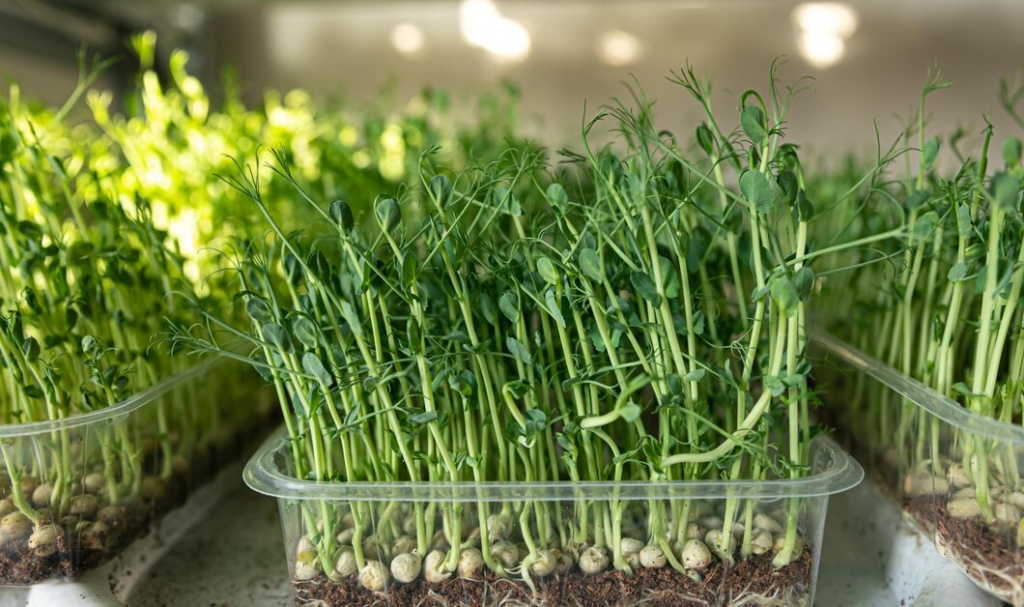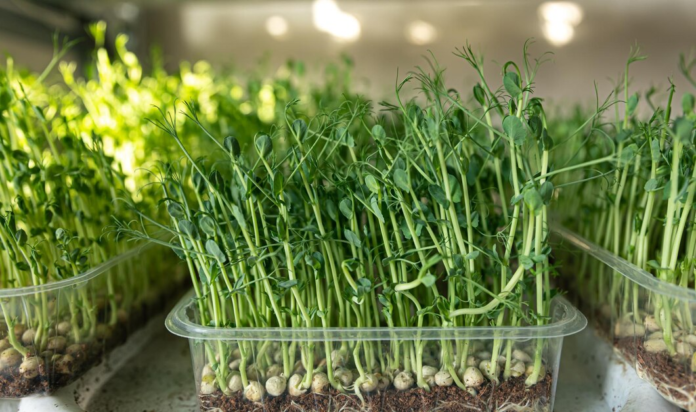Microgreens, those tiny, nutrient-packed greens harvested at an early stage of growth, have gained popularity for their vibrant flavors and nutritional benefits. Growing microgreens indoors is a simple and rewarding way to elevate your culinary creations while enjoying the satisfaction of cultivating a mini garden in the comfort of your home. In this comprehensive guide, we’ll explore the step-by-step process of growing microgreens indoors, from selecting seeds to harvesting these flavorful, nutritious gems.

What Are Microgreens?
Microgreens are the young, edible seedlings of vegetables and herbs. Harvested when the first true leaves emerge, microgreens are packed with flavor, color, and a concentrated dose of nutrients. Popular microgreen varieties include broccoli, radish, arugula, kale, and basil, among others. Growing microgreens indoors allows you to have a fresh supply of these delicate greens throughout the year.
Getting Started: Choosing the Right Seeds
1. Selecting Seeds:
- Choose high-quality, untreated seeds specifically labeled for microgreen cultivation. Popular microgreen varieties include broccoli, radish, sunflower, pea shoots, and cilantro. Experiment with different flavors to create a diverse mix of microgreens.
2. Seed Mixes:
- Explore pre-made microgreen seed mixes for a convenient blend of complementary flavors and textures. These mixes often combine seeds with similar germination and growth rates, ensuring a harmonious harvest.
3. Organic and Non-GMO:
- Opt for organic and non-genetically modified (GMO) seeds to ensure the purity and quality of your microgreens. Organic seeds are free from synthetic pesticides and chemicals.
Setting Up Your Indoor Microgreen Garden
1. Containers:
- Choose shallow containers or trays with drainage holes to prevent waterlogging. Flat trays or seedling trays work well for growing microgreens. Ensure the containers are clean and sanitized before planting.
2. Growing Medium:
- Select a soilless growing medium or a high-quality potting mix for microgreens. These lightweight mediums provide optimal aeration and drainage. Avoid using garden soil, as it may contain contaminants.
3. Watering:
- Keep the growing medium consistently moist but not waterlogged. Use a spray bottle or a gentle watering can to avoid disturbing the delicate microgreen seeds. Ensure the containers have proper drainage to prevent water accumulation.
4. Lighting:
- Provide adequate light for your microgreens. A sunny windowsill with at least 4 to 6 hours of sunlight is suitable for some varieties. Alternatively, use fluorescent grow lights positioned 2 to 4 inches above the microgreens for consistent and controlled light exposure.
5. Temperature:
- Microgreens generally thrive in moderate temperatures. Maintain a temperature range of 60 to 75°F (15 to 24°C) for optimal germination and growth. Avoid exposing them to extreme temperature fluctuations.
6. Humidity:
- Maintain moderate humidity levels for successful microgreen cultivation. If your indoor environment is dry, consider using a humidity tray or a humidifier to create a more favorable growing environment.
Planting and Growing Microgreens
1. Seed Preparation:
- Before planting, rinse the microgreen seeds thoroughly to remove any debris. Soak the seeds in water for a few hours or overnight to kickstart the germination process.
2. Sowing Seeds:
- Evenly spread the soaked seeds over the prepared growing medium in the containers. Press the seeds gently into the surface without burying them. For densely packed microgreens, aim for about 10 to 20 seeds per square inch.
3. Covering Seeds:
- Cover the seeds with a thin layer of additional growing medium or vermiculite. Lightly press down to ensure good seed-to-soil contact. This covering helps retain moisture during germination.
4. Germination Period:
- Place the containers in a warm, dark location for the initial germination period. This typically takes 2 to 4 days, depending on the variety. Once the seeds germinate and sprout, move the containers to a well-lit area.
5. Providing Light:
- If using natural sunlight, place the containers on a sunny windowsill. For artificial light, turn on the grow lights for 12 to 16 hours per day. Adjust the light height to ensure the microgreens receive adequate illumination.
6. Watering During Growth:
- Continue to water the microgreens regularly to keep the growing medium consistently moist. Use a gentle spray or watering can to avoid dislodging the delicate seedlings. Monitor the moisture levels closely.
7. Thinning Out:
- Once the microgreens reach a height of 1 to 2 inches and develop their first true leaves, consider thinning them out if they appear overcrowded. This allows the remaining seedlings more space to grow.
8. Harvesting:
- Harvest your microgreens when they reach the desired height, typically around 1 to 3 inches. Use clean scissors or shears to snip the microgreens just above the soil surface. Harvest just before use for the freshest flavor and highest nutrient content.
Common Challenges and Tips
1. Leggy Growth:
- Leggy or elongated growth can occur if the microgreens receive insufficient light. Adjust the light source or provide more direct sunlight to promote compact growth.
2. Damping Off:
- Damping off, a fungal disease affecting seedlings, can be prevented by maintaining proper sanitation and avoiding overwatering. Ensure good air circulation and use clean containers and tools.
3. Mold or Mildew:
- Mold or mildew may develop in humid conditions or if the microgreens are overcrowded. Increase ventilation, reduce humidity, and thin out the seedlings to prevent these issues.
4. Choosing the Right Containers:
- Select containers with proper drainage to prevent waterlogged soil, which can lead to root rot and other issues. Ensure the containers are appropriately sized for the number of microgreens you intend to grow.
Enjoying the Fruits of Your Indoor Garden
Growing microgreens indoors offers a delightful and accessible way to incorporate fresh, flavorful greens into your daily meals. Whether you’re a seasoned indoor gardener or a beginner, the process of cultivating microgreens is relatively simple, and the results are rewarding. Experiment with different varieties, mix and match flavors, and savor the joy of harvesting your mini greens for a nutritional boost in every bite. Happy growing!
Also read: How To Propagate Prayer Plant


